The Kilmahog Bell
The following article was written by our contributor Sue Mackay from Callander Heritage. Reprinted with permission.
The bell which now hangs over the entrance arch to Kilmahog burial ground, is called Donald the Hammer’s Bell. It original came from a barn on the shores of the Lake of Menteith. It was rung by anyone wanting a boat to carry them over to the Earl of Menteith’s Castle on Inch Talla. In the 17th century it was stolen by a Highland raiding party and carried to Balquidder, where the raiding party stayed the night. It was left there in payment for their overnight entertainment. In the 18th century it was accepted by a McLaren in Blairgarry in lieu of payment for a debt and he returned it to Kilmahog in 1819 where it hung between the forked branches of a tree setup between the graveyard and the road, where it was rung to mark burials.The Laird of Leny subsequently took it into Leny House, but a descendant of the original McLaren owner objected. After many years lying in a Callander bank it was set up in its present position in the 1890s.
Sue Mackay, Callander Heritage
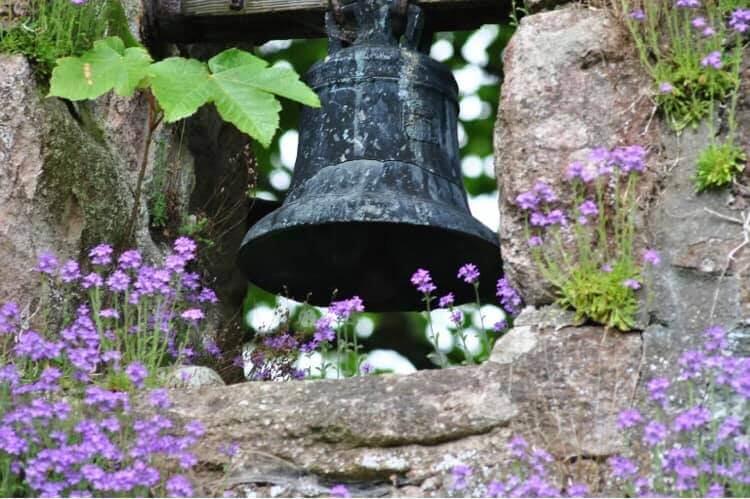
Kilmahog Cemetery
Articles from The Stirling Observer
Between September – December 1888 a rather “animated” conversation arose in the letters to the editor section in The Stirling Observer newspaper. Our volunteer, Ann Windsor, has graciously transcribed the later ones for us.
13 Sep 1888
4 Oct 1888
25 Oct 1888
22 Nov 1888
29 Nov 1888
6 Dec 1888
Snippings from the Stirling Observer, Thursday 6 December 1888
KILMAHOG BELL.
SIR, – Before the correspondence on this subject is closed, permit me to ask if it is not time for something more to be done to improve this old burying-ground, and, along with that, steps might be taken to have the bell restored? I believe an effort was made a few years ago to raise the necessary funds. Can any of your correspondents state who was appointed treasurer, and what money he may have on hand? – I am, &c.,
ANOTHER INTERESTED ONE.
SIR, – You know I had no desire to inflict upon your readers in one day, on the same subject, two letters, which, although not so indistinguishable from each other as the proverbial twins, savoured, as your accomplished friend Mr Maude would say, of “repetition ad nauseam.” The following, apart from its connection with the subject of the bell, and apart from any interest of its own, brings home to our own doors the striking contrast between our peaceable days, when every man may (figuratively speaking) sit under his own vine and under his own fig tree, no one daring to make him afraid, and the exciting times of little more than a century ago. I quote first now from sir Walter Scott:- “One of the lairds of Balquhidder, Maclaren of Wester Invernenty, escaped sharing the fate of many of his countrymen, who suffered at Carlisle for their share in the troubles of 1745. A party of dragoons were conducting him to Carlisle to take his trial as a rebel, and just as they had ascended an eminence near Moffat, where the rivers Tweed, Clyde, and Annan originate, and descend in different directions, the former to the German Ocean and the two latter to the Atlantic, the prisoner requested permission to step aside, which was granted. Seeing his guard sauntering on inattentive to their duty, he seized the favourable moment, tumbled heels over head from the top to the bottom of the declivity, and ran on with astonishing swiftness. Favoured by a fog he gained a morass, into which he darted for safety, and soon dis-covered a hole whence peats had been dug, in which he immersed himself up to the neck, his head being covered with turf. In this situation he remained till night, when he found his way across the country to the place where his wife lived near his own property, and disguising himself like a woman, he continued unmolested till the Act of Indemnity passed, which enabled him to show his face without fear of peril. This is the foundation of “Pate in peril” in the novel of “Redgauntlet.”
The place where Maclaren leapt over the precipice is still known at Moffat as “Maclaren’s leap.” Maclaren, here spoken of was the father of Archibald Maclaren, donor the Kilmahog bell. “ We are all proud of Sir Walter Scott as being the greatest man Scotland has yet produced, but the sun has its spots, and Sir Walter had his little weaknesses.
One of these was a tendency to depreciate those who might otherwise dim the glory of his heroes. The Maclarens acquired Invernenty by marriage with the Stewarts of Appin, and the main condition attached to their acquisition of the property was, that they were to keep in check the McGregors. Consequently, as it was Sir Walter’s aim to throw so much halo and romance around Rob Roy and his clan, he did not hesitate to be often unfair to their natural foes, the Maclarens. It is no surprise then to find that Maclaren never lived in disguise as a woman. The Maclarens fought at Culloden under the flag of the Stewarts, and our friend, after that disastrous battle, made his way, at great risk, as far as Braeleny. Not daring to go home, he and some companions in misfortune lived here in a rude hut for some time. At length they were discovered, and, after some useless firing from their shelter at the Government soldiers, they surrendered. When on the march under escort to Carlisle to be beheaded, a halt was made at a wayside inn near Moffat for refreshments. Maclaren, having been in the habit of going south to the markets to dispose of his cattle, was well known to the innkeeper.
The latter accordingly, on a signal from Maclaren, plied the soldiers with abundance of liquor. After resuming their march, Maclaren desired and obtained leave to go aside. The Captain, however, kept his eye on him, and thinking he was moving too far away cried, “Halt!”
Maclaren replied by a wave of the hand, accompanied with, “Good-bye, Captain.” The Captain instantly fired, but missed, and next moment Maclaren was down the precipice into a dense fog hotly followed by a search party. He lay for two or three days under the bank of a peat bog, and frequently he saw the soldiers quite close to him. At length he ventured by night to a house where he was known, had food and a change of clothes.
Making his way home as stealthily as he could, he required to cross a bridge. On the bridge he met a shepherd, and as the shepherd might give fatal information to his pursuers, Maclaren gave him the choice of instant death or of submitting to be tied there. He wisely chose the latter alternative, Maclaren being a very powerful man. At last Maclaren got safely to Brig of Turk, and spent there the remainder of his days. Like many other small lairds, he did not get his property back from Government. – I am, &c.,
AN INTERESTED ONE.
SIR, – The very interesting history of Mr Archibald McLaren, sometime tenant of Blairgarry, the donor of the above ancient relic, and of the sterling qualities of his worthy ancestry, must prove of much interest to many readers. Equally interesting, though meagre, in the partly historical partly traditional accounts given of the relic itself. Fortunately, these accounts can be largely supplemented. It has often been asserted that the bell was taken from the Priory of Inchmahone, “Isle of St. Colomoc,” or the “Island of Rest,” by none other than the redoubtable Rob Roy MacGregor in one of his forays on Montrose’s “Girnal” in Menteith. The Priory was founded for Austin Canons Regular in the 13th century by Walter Comyn of Badenoch, who acquired the island by marriage with the Countess of Menteith. The tower arch, along with two arches of the nave and part of the choir, now alone remain; and it is asserted that it was the mellow chime from the belfry in the lofty tower, of the identical bell above referred to, which, more than six hundred years ago, used to call, with hastened steps, the Prioress and hooded Nuns from “The Nuns’ Walk,” to their solemn devotions within the sacred precincts. It is also asserted that at a much later period – about the year 1712 – the bell was frequently used for a more secular purpose. Many of Montrose’s tenants in Menteith at that time paid their rents, some wholly, some partly in grain or meal, which was lodged in a storehouse or granary called “The Girnal,” situated near the shore of the Lake of Menteith, and opposite to the Priory.
Now, Rob’s favourite plan, when he found his own Girnal empty, was to replenish it with the best grain procurable from the Girnal of Montrose. The island at that time was in the possession of Montrose, and as the tower of the Priory was the only place of vantage in the neighbourhood, a watch was generally kept there, so that due warning might be given of Rob’s approach. He cared little for this, however, and as the communication with the shore was by means of a boat, his approach was generally first announced by his arrival the Girnal. But when they hit upon the expedient of using the little bell on the occasion of his visits at the most suitable moment to sound the alarm far and near for his capture, he found it essential for his safety to have it silenced if he was to continue his forays on the “Girnal.” Whether he forced Graham of Killearn, Montrose’s factor, to do his bidding on this as on other occasions, and give up the bell, or by what other means he obtained it, is not stated; but, at all events, one fine morning saw him cross the upper reaches of Lochs Drunkie and Vennachar, and enter the forest of Glenfinglass with the bell at his saddle, and the same evening saw him deposit it in his house at Inverlochlaraig in the Braes of Balquhidder. Rob resided there until his death in 1738 – exactly 150 years ago. After his death, the bell came into the hands of Steuart, a tenant of Gartnafuaran in Balquhidder, a farm adjoining that of Inverlochlaraig, at which Rob resided. Stewart sold it to Mr Archibald McLaren about 1779, and a few years later he erected it a Kilmahog, as already mentioned in your columns. Forty years ago it was appropriated and lost sight of, and has just been discovered in the hands of the man Stewart. In point of fact, its vicissitudes have been so numerous and varied that the owners when now erecting it should make it secure for a long time to come. The suggestion made by “An Interested One,” for instance, for having it placed on one of the trees is open to very serious objection. The trees being outside the walls are the property of the proprietor, and he might cut all or any of them down at any time. To prevent this and secure its preservation, the admirable suggestion made by “Indagator,” that the structure on which it is to be erected “should be placed within the walls, and should combine the qualities of being at the same time durable, pleasing to the eye, and constructed so as to protect the gift from the elements and from danger,” should be adopted. A block of say Ben Cruachan granite of suitable design, with a cavity near the top for containing the bell, constructed so as to protect it from the weather, might be suggested as most suitable. Let the owners of the relic – i.e., the lairholders – for- ward their subscriptions to any one of their number who has the good of the district at heart who will collect the funds necessary, say, for instance, Mr Robert McLaren of Annie, a gentleman ever ready to help in a good cause, and this will be the means to the end. “Scrutator” will himself add his mite. – Yours, &c.,
SCRUTATOR. Callander, 6th December, 1888
[This correspondence must now cease.]

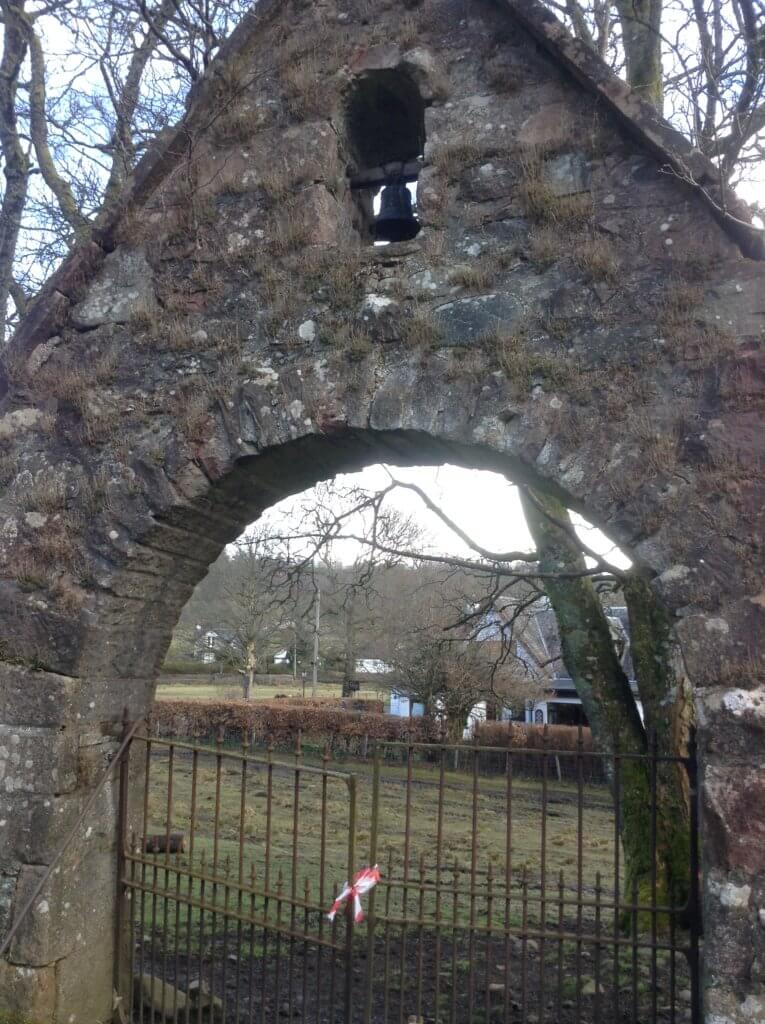
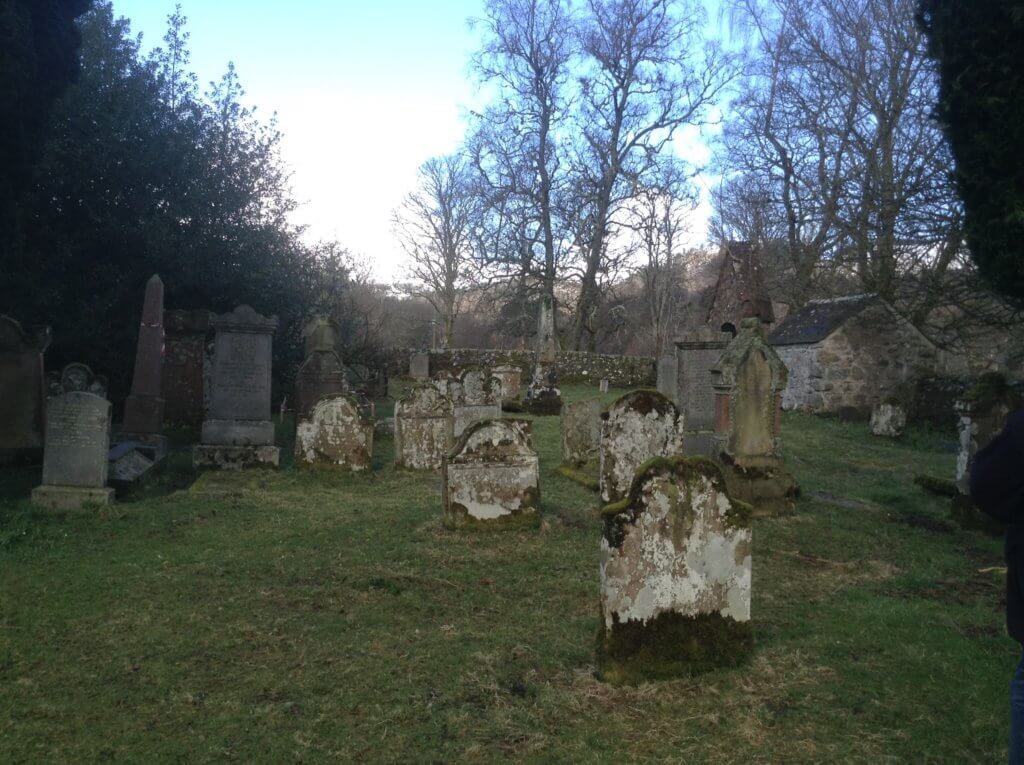
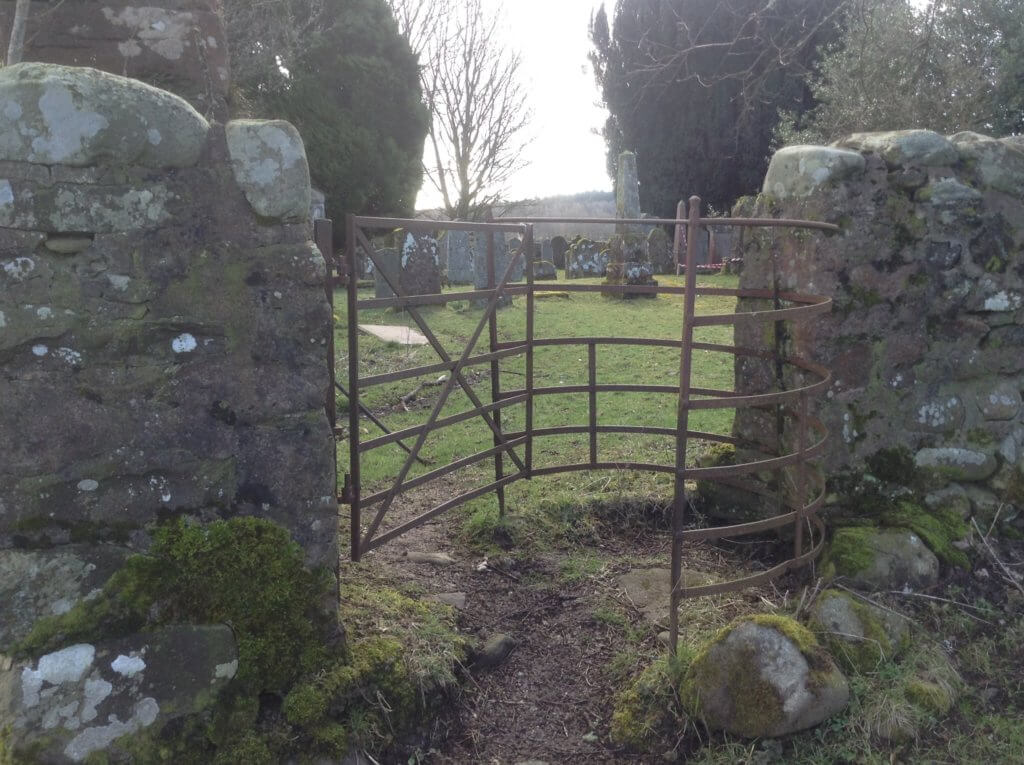
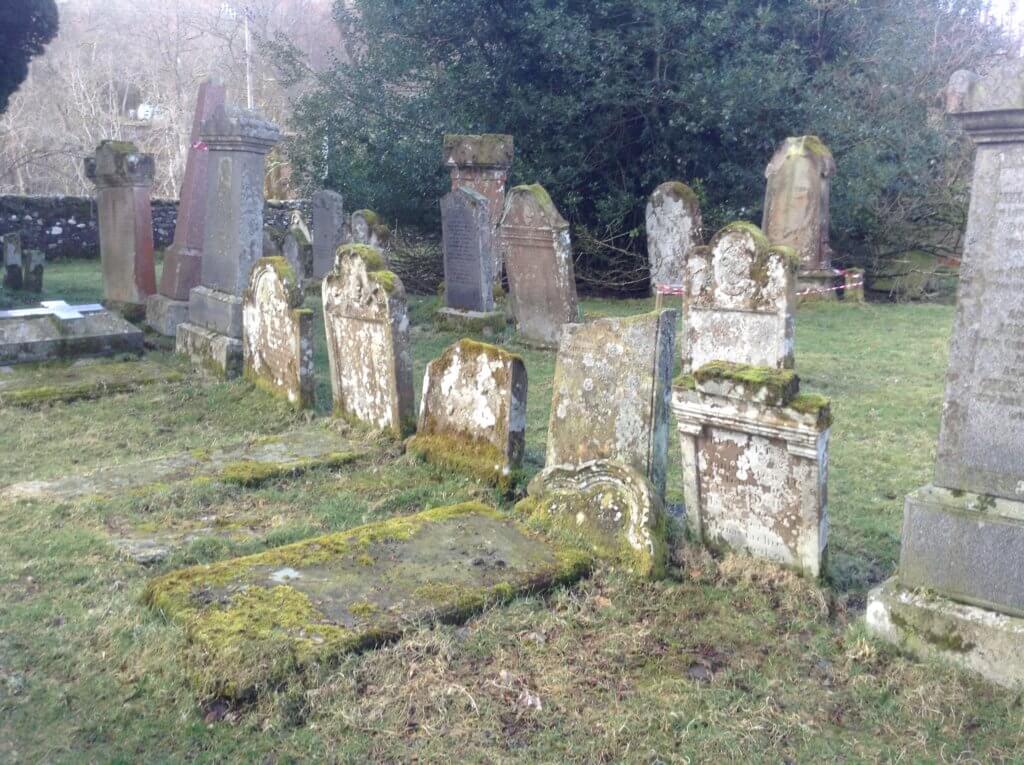
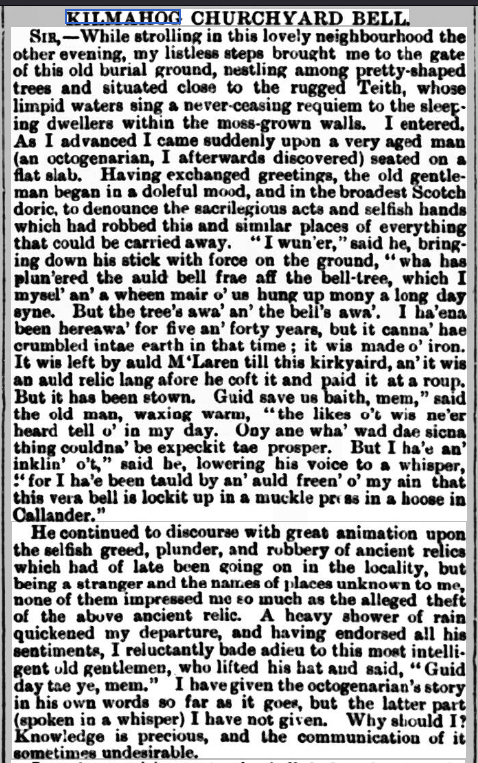
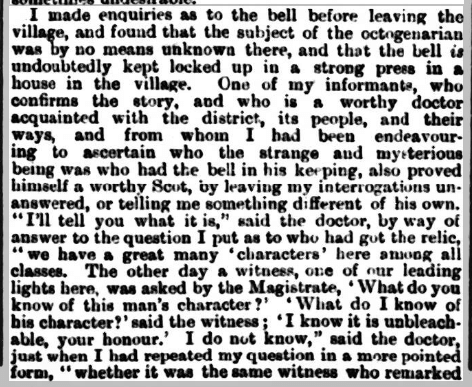
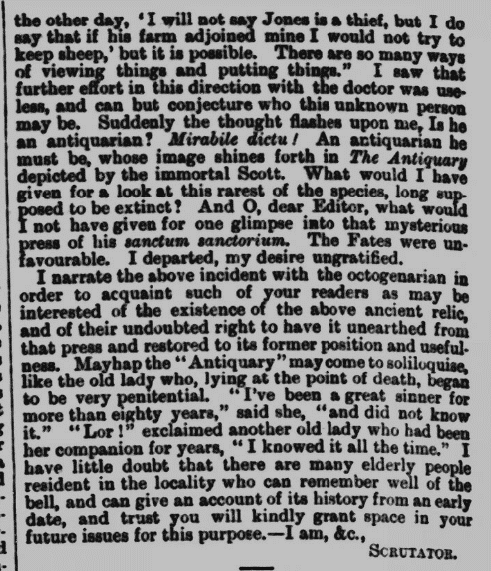
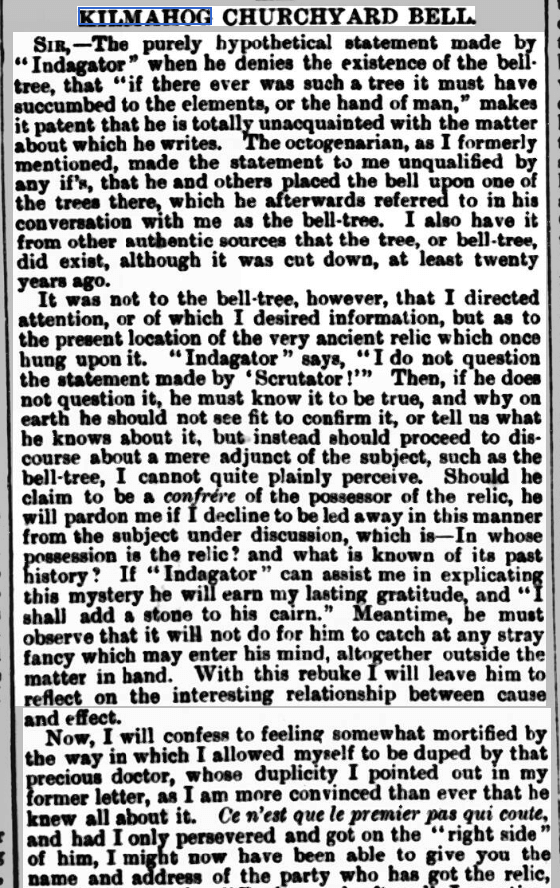
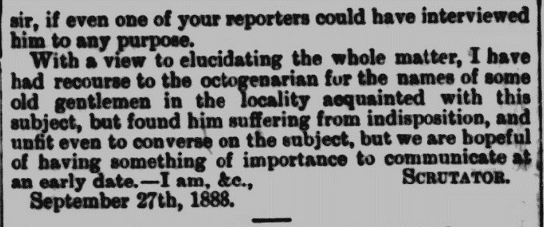
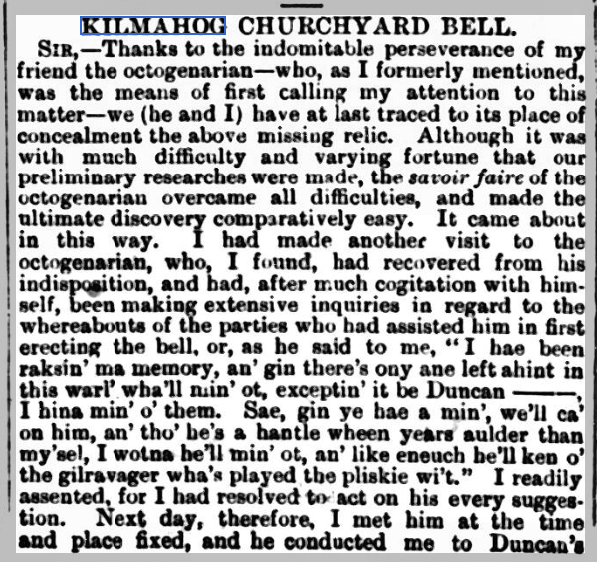
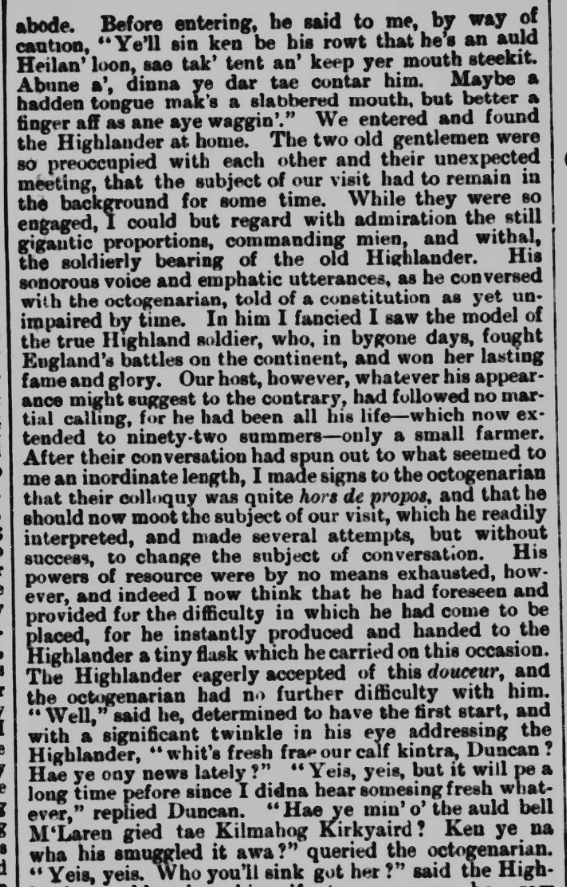
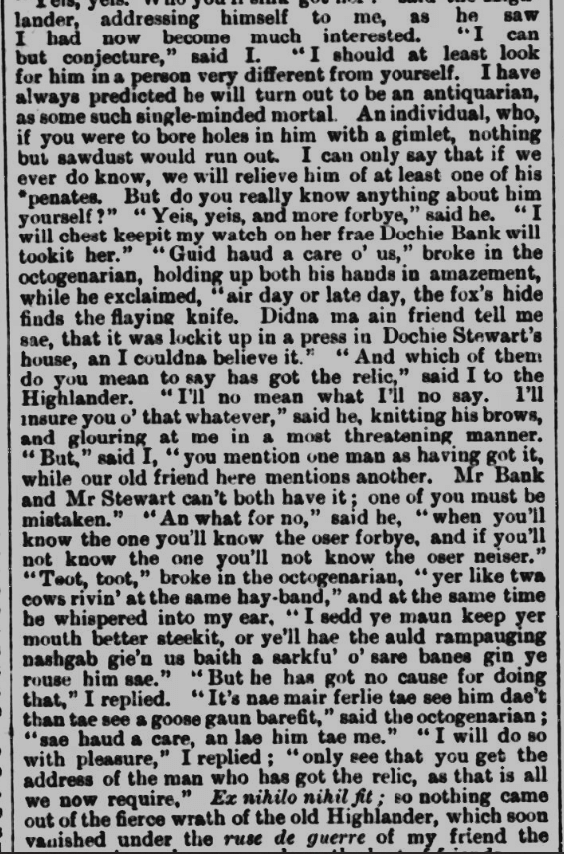
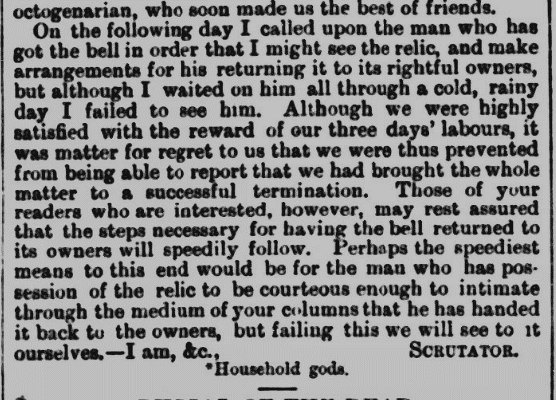
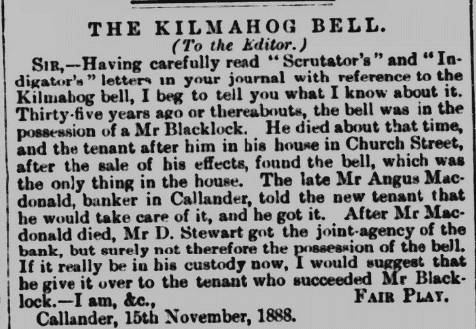
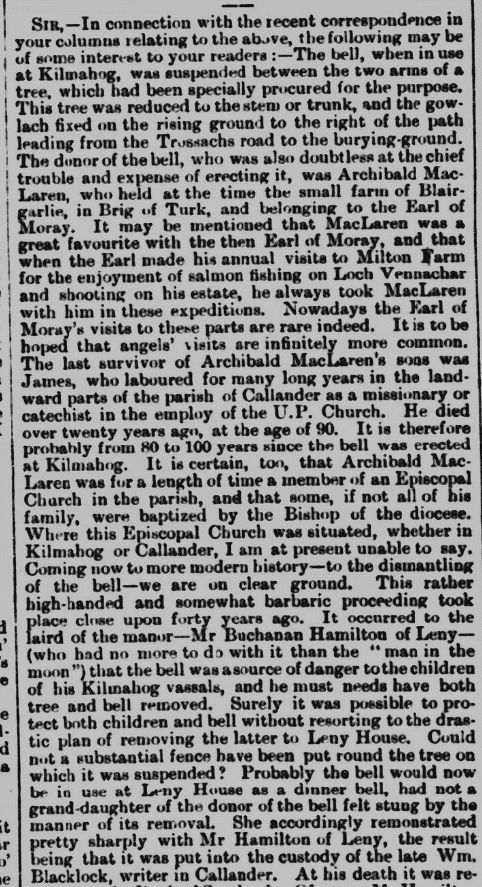
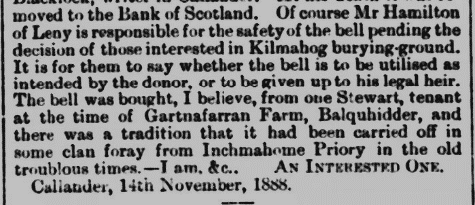
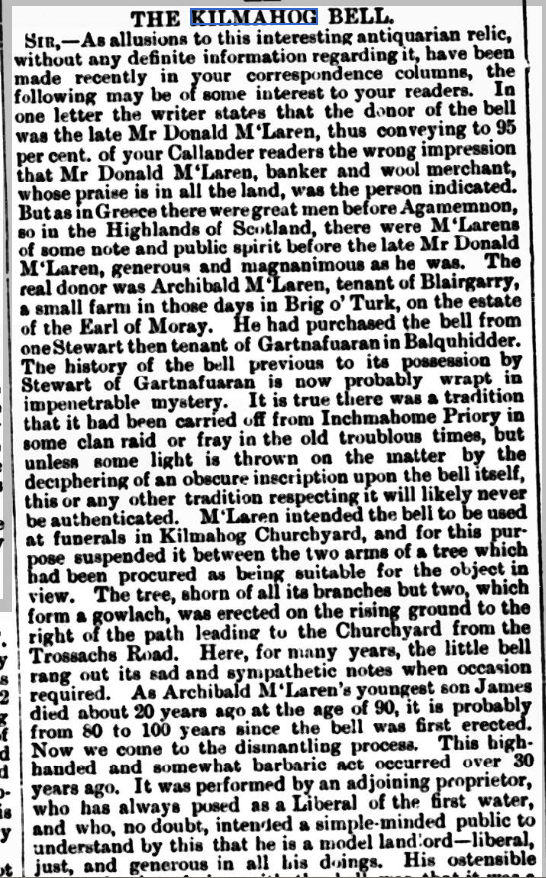
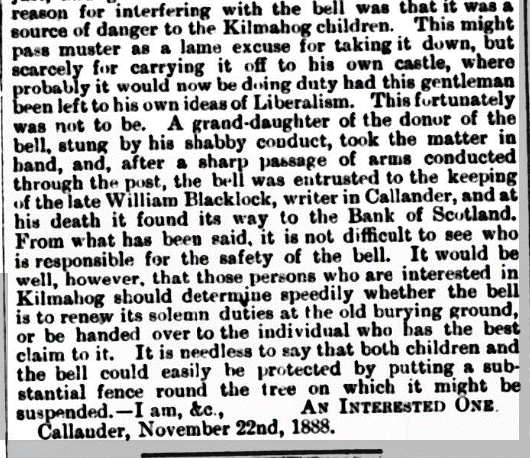


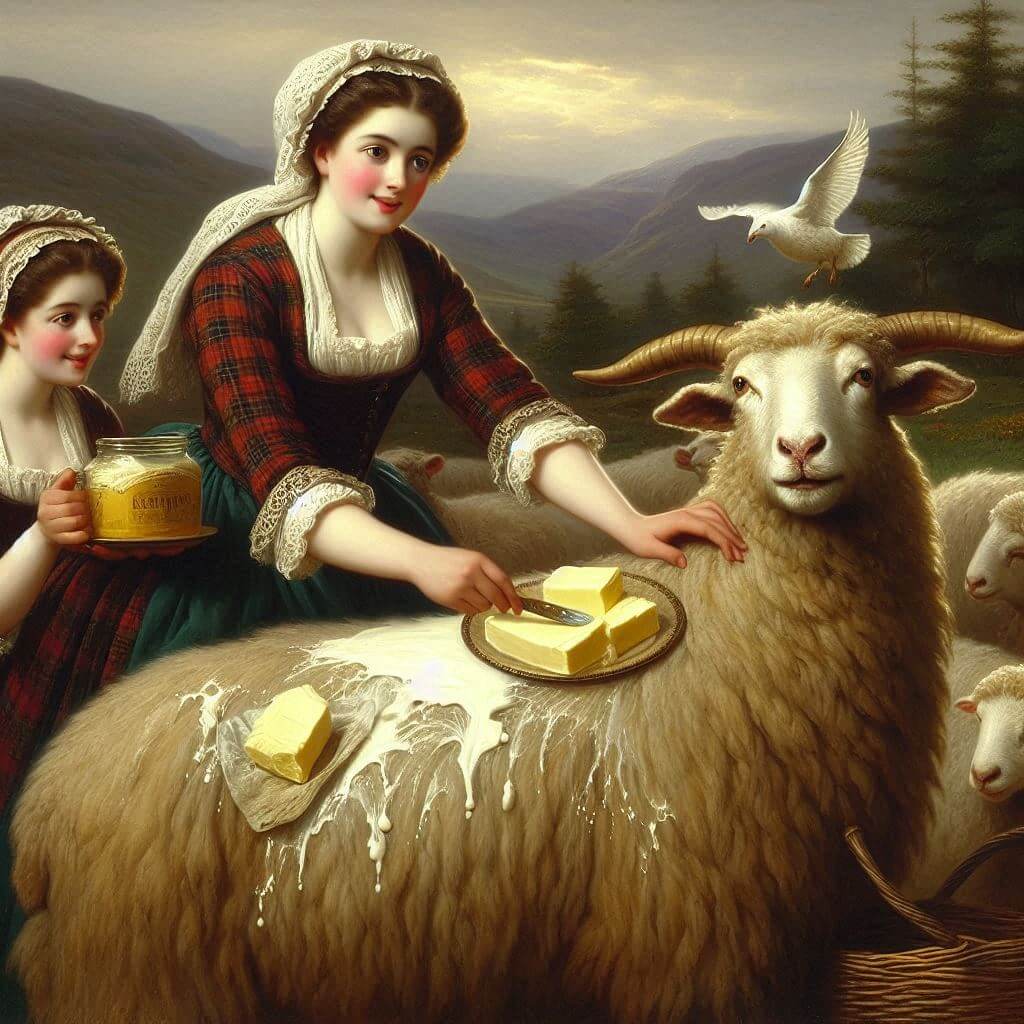

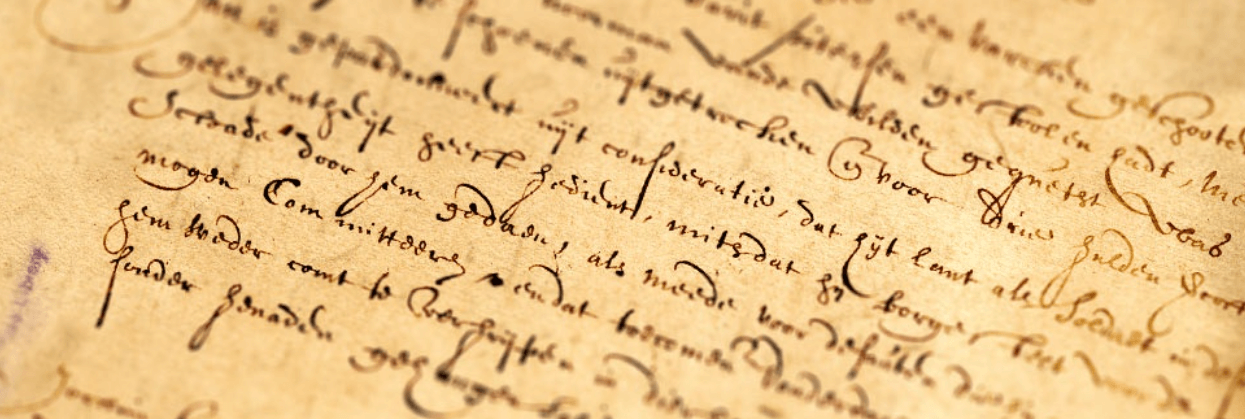
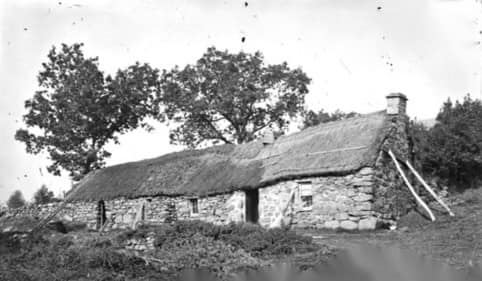
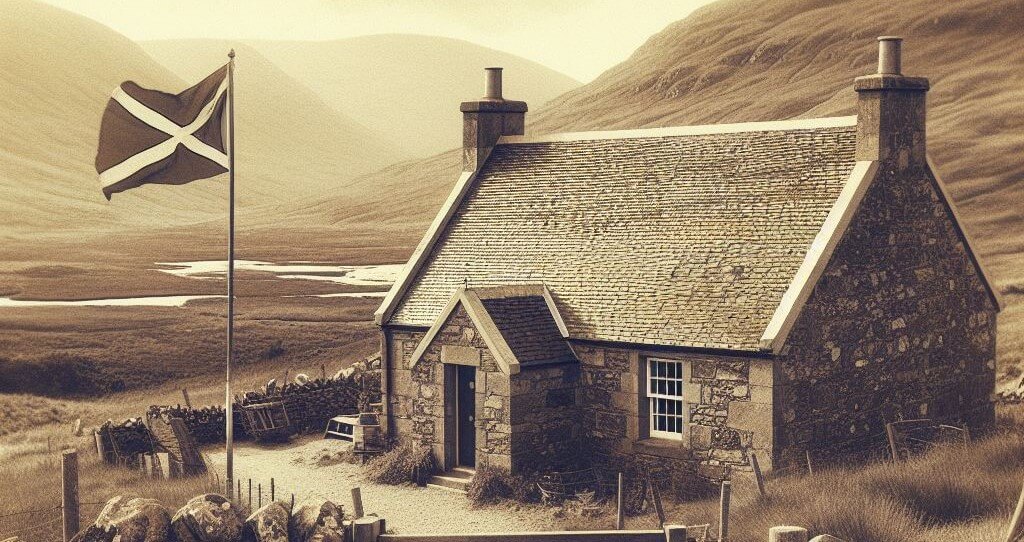
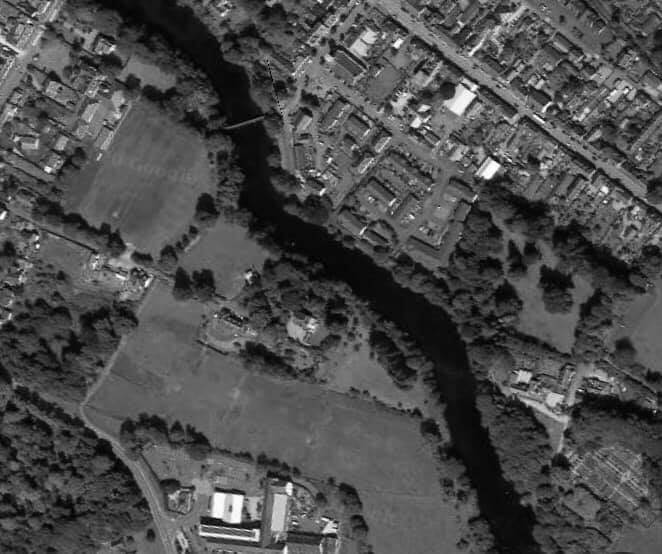
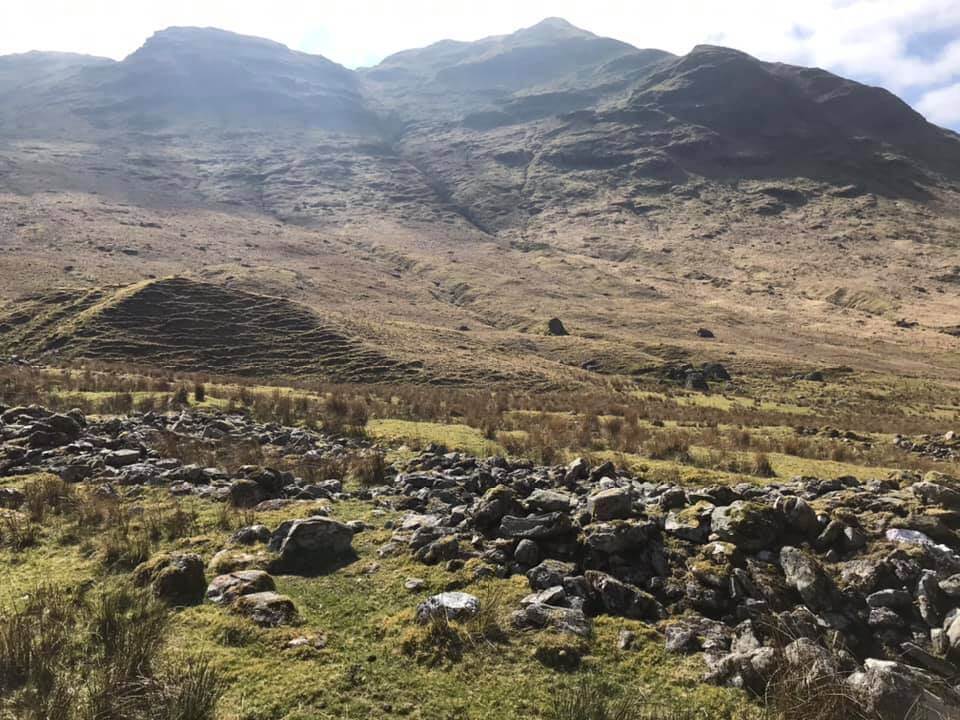
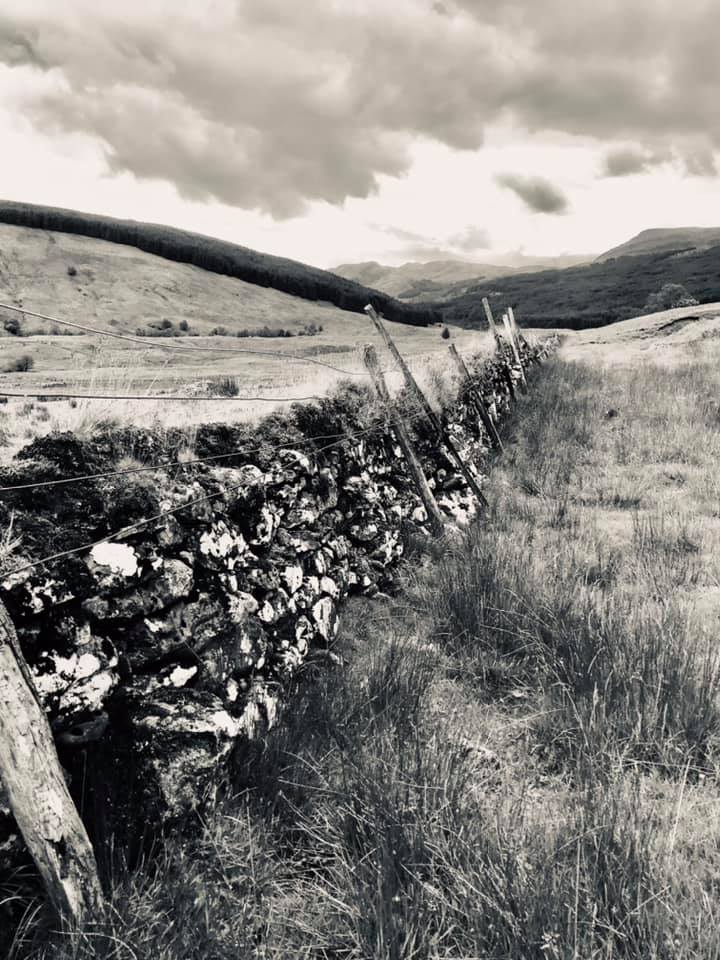
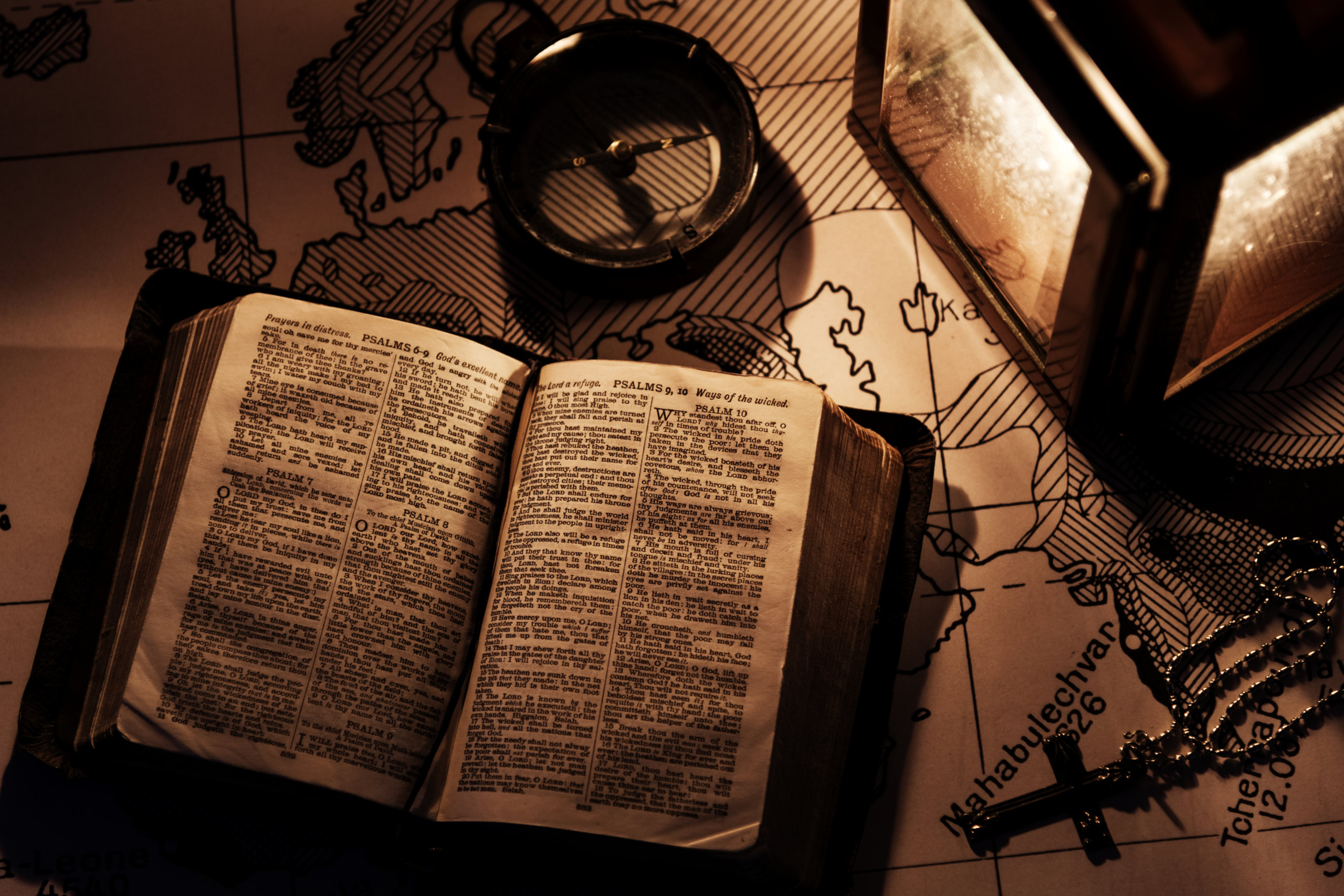
0 Comments